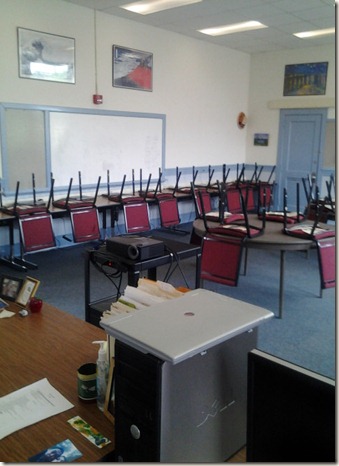Tearing down and rebuilding our schools is hardly a tasteful option in an era of tight budgets and a total lack of funding. What can we do then? We can start by redesigning our classrooms from places where “knowledge is imparted” to more of place where knowledge is found, discovered in a collaborative manner. We can turn the physical environment into places where authentic learning is the classroom business, not sitting in rows, listening to lectures. This may mean simply getting rid of desks and moving in tables and chairs that are portable and can be rearranged quickly according to the needs of the students and the teachers. It means we can change our physical spaces in our schools into 21st century learning environments without breaking our budgets.
The building we currently occupy was constructed around 1929, so you can imagine its limitations. Yet, each teacher in our building has consciously worked to create learning spaces that capture the philosophy and spirit of our school: collaboration, engagement in authentic learning, and using technology. Here’s a photo of one of our English classrooms.

I know, you can see chairs stacked on the tables. Even 21st century classrooms need vacuuming, but if you look closely, you see tables arranged along the walls, and on those tables are laptops. Students work seated at the tables and the teacher has room to move about to assist students and monitor what they’re doing. Two tables are placed in the center of the room both for students who bring their own laptops, and for meetings among collaborative groups. It is not your normal English classroom arrangement. In this case, students can turn their chairs to attend to the teacher at the beginning of the class, then turn to their computers when it’s time to engage in whatever their projects ask them to do.
The space is arranged to facilitate, not lecturing, but engagement in using 21st century tools in authentic learning tasks and maximize collaboration. How a classroom is arranged tells a great deal about what happens the most in it.
Let’s look at another classroom.

Tables, tables, tables everywhere. No desks in rows. In fact, we do not have a single old-fashioned desk in the building and that is by design. In the 21st century students need to work collaboratively and having highly portable tables allows for maximum collaboration. This is a science classroom. Students are purposefully seated at tables in this room so that they can work on collaborative science projects. The chairs and tables can be turned and used in multiple configurations, depending on the needs of the class. Out of the picture, is a small lab of desktop computers that students can use, along with their own personal laptops and devices as well.
So, what does this say about our school? Even though we inhabit an older building designed for 20th century pedagogy, we can purposefully redesign our spaces for 21st century learning. But keep in mind, we all know that just changing spaces does not necessarily mean a change in pedagogy. We should know that from the “Open School debacle back in the late 60s and early 70s. Still, purposefully redesigning spaces for 21st century learning in your school does not have to be an expensive undertaking, but you can tell how a school conducts the business of teaching by how its learning spaces are designed.
No comments:
Post a Comment